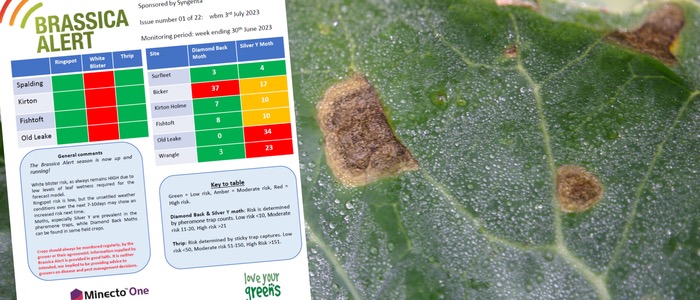Brassica Alert is now live for the 2023 season, providing growers and agronomists with up-to-date assessments and risks of key pests and diseases, to aid proactive agronomy decisions.
Created by Syngenta, Brassica Alert draws on independent data and assessments by the Allium & Brassica Centre.
Growers and agronomists can sign up for free text messages of the weekly results, or download a report direct from the Syngenta website.
Diseases and pests covered by Brassica Alert include ringspot and white blister, thrips, silver Y and diamond back moth.
Disease information gathered in crops across Lincolnshire is combined with in-field weather data to assess risks of white blister and ringspot, along with expert analysis and observation of factors such as the presence of sporulating lesions as a source of inoculum, or prolonged morning dews that would increase issues as the season progresses.
Pheromone traps
Moth pest threats are determined by pheromone traps in six locations, with species analysed and reported separately. Risks of crop damage are assessed as low where less than 10 specific moths are caught, rising to moderate at 10 to 20 moths and high risk if more than 20 are caught.
Thrips are monitored by sticky trap capture, with low risk below 50 thrips; moderate at 50 to 150 and high above 150 per week.
Risks for all pests and diseases are categorised by a simple green; amber; red traffic light system.

Simon Jackson
Syngenta technical manager, Simon Jackson, advocated Brassica Alert provides a valuable picture of agronomic pressures across the primary eastern counties production areas, along with advance warning of potential risks to optimise crop protection decisions.
“Using Brassica Alert to track risks of ringspot can help to optimise timing of preventative Amistar Top applications to protect against outbreaks, for example,” he advised. “Amistar Top will also give control of white blister, if that is seen to be active at the same time.”
Allium & Brassica Centre trials have shown that using Brassica Alert to adapt agronomy programmes, as part of an IPM strategy, can enable growers to maintain the same high levels of disease control with fewer well-timed fungicide applications, compared to routine fixed-interval treatments.
Mr Jackson added that changing climatic conditions has seen timings of pest migrations vary widely in recent seasons. “Pheromone trapping of moths in crops gives a crucial early warning of potential damaging infestations. The results highlight the variability in pest pressure across the region, particularly in early season.”
Results of the first week’s reported monitoring, for example, identified high pressure numbers of silver Y moth in two locations, medium amber pressure on three sites, but a low pressure of just four moths in another location trap. It also demonstrated that populations of the two moth species can be very different on the same site.
“With an extended season of pressure growers will require all the options available. Using Brassica Alert to assess risks for moth and thrips can help pick the most effective timing in the programme for Minecto One treatments in cabbage, cauliflower, Brussels sprout and broccoli.”
This season there is a new EAMU for the use of Minecto One on kale and collards for control of diamond back moth (Plutella xylostella) and other caterpillar species, along with control of flea beetle (Phyllotreta sp) and cabbage stem flea beetle (Psylliodes chrysocephala) on oriental cabbage. Growers are reminded that EAMUs are also in place for thrip and leaf miner in leeks, with full details of all EAMUs on the HSE website.
Growers and agronomists can sign up for Brassica Alert now on the Syngenta website: www.syngenta.co.uk




